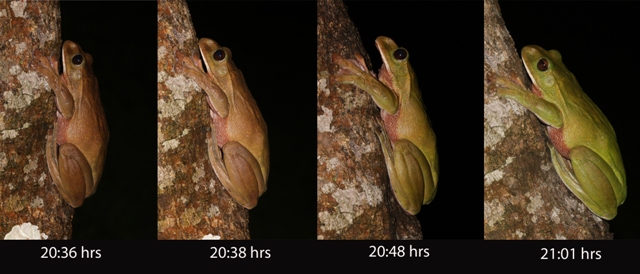by Neha Jain on 21 October 2019
• Researchers witnessed a swift change in colour of a giant tree frog, from green to brown and then back to green, in a tiger reserve in Arunachal Pradesh.• They believe that the initial colour change could have been caused by disturbance, which triggered a predator deterrence response, or it was simply a result of physiological stress.
• Male frogs are known to change colour during the breeding season to attract mates. But frogs also change colour to camouflage themselves to escape predation, to communicate with other members, and to regulate their temperature, among other reasons.
Reptiles such as chameleons are famed for changing their colour and amphibians such as frogs often escape the radar.
Not this time though.
Researchers at a tiger reserve in the eastern state of Arunachal Pradesh have reported witnessing a striking spectacle: a giant green-coloured tree frog turned brown in a matter of minutes when placed on a tree trunk and then transformed back to green again, leaving the team awestruck.
This could have been a predator deterrence response or a byproduct of hormones released due to physiological stress.
“I was really surprised to see the pace at which it changes its body colour from green to brown as we placed it on a brown-coloured tree trunk. We couldn’t quantify the time taken for this colour change as it took us by surprise!” said lead author Deepak C.K., a senior project fellow working with the Zoological Survey of India, Kolkata.
Afro-Asian tree frogs belong to the family Rhacophoridae and within this family the genus Rhacophorus, which is the largest, was split into two other genera, Leptomantis and Zhangixalus, earlier this year. Rhachophorus comprises around 39 species that are distributed in the tropical regions of India, Southeast Asia, China and Japan. Past reconstructions have suggested the ancestral area of Rhacophorus to be Southeast Asia, from where it spread to the Indian subcontinent.
The range of the Giant tree frog Rhacophorous smaragdinus (Blyth, 1852) (now Zhangixalus smaragdinus) spans from northeastern India and Nepal to the Southeast Asian countries of Laos, Cambodia and Vietnam, going all the way upto southern China.
Brown or green? It depends on the situation!
C.K.’s team was surveying reptiles and amphibians at night in Namdapha Tiger Reserve as part of a project by the Ministry of Environment, Forest and Climate Change to document the biodiversity of fauna in the Indian Himalayas, when they captured a huge frog (12.6 cm length from snout to vent). The project is funded under the National Mission on Himalayan Studies and guided by Kailash Chandra, director of the Zoological Survey of India.
Located in Changlang district of India’s easternmost state of Arunachal Pradesh near the Myanmar border, Namdapha Tiger Reserve is a biodiversity hotspot. Part of the eastern Himalayas, the park’s vegetation changes with elevation—from tropical evergreen forests in the low, deep valleys to temperate broadleaf and mixed forests higher up in the mountains.
Researchers captured the sequence of color change from brown to green in Rhacophorus smaragdinus (now Zhangixalus smaragdinus). It took 25 minutes from the first photo on the left to the last one. This change was relatively slow compared to the initial colour change from green to brown upon handling. Photo courtesy C.K. et al. (2019).
The adult female frog R. smaragdinus, which was clinging onto a branch three metres above the ground, was first spotted in a vivid shade of lime green. But when the researchers transferred it to a tree trunk to take photos, it swiftly flashed into a shade of brown within a span of a few minutes—blending in perfectly with the background.
After it was left undisturbed for a while, it turned back from brown to green but this time it took longer—25 minutes—and they managed to capture its transformation in photos. But it had taken longer than this to return to its original green hue.
“Although I have heard about colour changing behavior in some tree frogs from the Western Ghats from batrachologist friends and read papers about the behaviour in tree frogs of Neotropical region (South and Central America), this was the first time I was witnessing it,” said C.K.
Why and how do frogs change colour?
While most of the work on colour-changing ability is well-studied among tree frogs from the family Hylidae that are found in North and South America, the West Indies, the Australo-Papuan Region and temperate Eurasia, there is scant information on Afro-Asian tree frogs (family Rhacophoridae)—and hardly any reports from India.
“This is what prompted me to publish this observation, although I have only observed it once,” said C.K.
The ability to change colour is well-documented among frogs during mating, where males undergo a temporary or permanent colour change to attract females.
So how many species change colour? “We don’t have great estimates of this because of course, you have to be in the right place at the right time to document it,” said Rayna Bell, Assistant Curator of Herpetology at the California Academy of Sciences. But in her 2017 study, Bell and colleagues found that reversible colour change during the breeding season occurs among a whopping 178 species from nine families based on past reports and observations. Yet, this is likely to be an underestimate, the authors stated—with time, more species that display this amazing ability are likely to be discovered.
Other reasons that can cause this fascinating phenomenon of changing colour are predator avoidance, communication with other members, and thermoregulation. Frogs display a diverse range of colours, which can change during handling, or in some cases, they fluctuate between day and night.
In this case, the authors suspect that the physical disturbance to the frog likely triggered a predator deterrence response resulting in the initial colour change from green to brown when placed on the tree trunk.
“Or it could be that the colour change doesn’t have any adaptive function but is merely a byproduct of certain hormones released due to physiological stress,” said C.K.
“The way to figure out is to conduct an experimental study which involves placing the frog in different coloured substrates under different conditions.”
Change in colouration can occur through two different processes. The first is morphological, which takes from days to months and involves changes in the density of the pigment-containing cells in the outer layer of the skin called chromatophores. This process generally occurs in some species during the breeding season as studied by Bell.
In contrast, the second—which likely occurred in this instance—is physiological, ranging from milliseconds to hours and entails the dispersion or aggregation of pigment granules inside the chromatophores. Physiological colour change is regulated by neuromuscular or neuroendocrine system making it a rapid and reversible process.
But this was just one opportunistic observation, cautioned the authors, stressing that more carefully designed experiments can provide greater insights.
“There is very limited understanding of these sudden colour changes,” said K.V. Gururaja, a batrachologist (amphibian specialist) and faculty at Srishti Institute of Art, Design and Technology, who was not connected with the current report. He has worked with Rhacophorus lateralis, the small winged tree frog, which, he said “changes colour from green to brown depending on the level of stress while handling or by flash light to take photographs.”
Varad Giri, director of the Foundation for Biodiversity Conservation in Pune, who was also not part of the observation team, says that he has also seen a few frogs changing colour under stress. Apart from stress, he noted observing “differently coloured frogs [individuals of] Raorchestes bombayensis in Matheran after the monsoon.” He describes that “during the breeding season all individuals look alike but after monsoon, when they hide under rocks in the stream, all the individuals were looking differently coloured.”
This colour change, he reasons, “is for crypsis [camouflage].” By blending in with the background, frogs can escape predation. “We have also observed different colour morphs in Amboli bush frog, Pseudophilautus amboli, but this is again for crypsis and not under stress.”
(Deepak, C. K., Payra, A., Tripathy, B., & Chandra, K. (2019). Observation on rapid physiological color change in Giant tree frog Rhacophorus smaragdinus (Blyth, 1852) from Namdapha Tiger Reserve, Arunachal Pradesh, India. Herpetozoa, 32, 95.)
– Mongabay India




